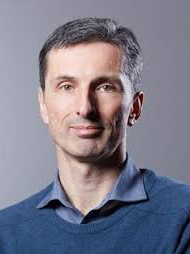TCBG Seminar
Molecular Simulations in Times of COVID-19 Tweet

PROFESSOR
Gerhard Hummer
Theoretical Biophysics
Max Planck Institute of Biophysics
Frankfurt, Germany
Thursday, October 22, 2020
11:00 am (CT)
Zoom webinar recording
Abstract
Mateusz Sikora (1,2), Laura Schulz (1), Florian Blanc (1), Sören von Bülow (1), Michael Gecht (1), Roberto Covino (1,3), Ahmad Reza Mehdipour (1), Gerhard Hummer (1,3,4,5)(1) Department of Theoretical Biophysics, Max Planck Institute of Biophysics, 60438 Frankfurt am Main, Germany (2) Faculty of Physics, University of Vienna, 1090 Vienna, Austria (3) Frankfurt Institute for Advanced Studies, 60438 Frankfurt am Main, Germany(4) Department of Physics, Goethe University Frankfurt, 60438 Frankfurt am Main, Germany(5) Buchmann Institute for Molecular Life Sciences, 60438 Frankfurt am Main, Germany We use molecular dynamics (MD) simulations to study key molecular processes of the SARS-CoV-2 virus. We concentrate on the structure of the spike (S) protein at the viral surface, its interactions with the host cell, and on viral modulation of the host immune response. In molecular dynamics (MD) simulations of full-length S with a palmitoylated transmembrane domain and a fully glycosylated ectodomain, we identified three hinges in the stalk connecting the S head to the viral membrane. Hinge flexibility and glycosylation have been confirmed by high-resolution cry-electron tomography (Turonova, Sikora, Schürmann et al., Science 2020). We are now using the detailed structural and dynamic models for a computational antibody epitope scan (Sikora et al., biorxiv). In addition, we study the interactions of S with the host- cell receptor ACE2 (Mehdipour, Hummer, biorxiv). In MD simulations of the SARS-CoV-2 papain-like protease PLpro, MD simulations provided detailed insight in its function as immunomodulator by suppressing the host interferon (IFN) and NF-κB pathways through preferential cleavage of ISG15 (Shin et al., Nature 2020). Overall, MD simulations help us to uncover some remarkable biology associated with viral infection and, as we hope, guide our fight against COVID-19. Acknowledgments. Our special thanks go to Martin Beck and Beata Turonova plus team (MPIBP and EMBL) for the electron tomography, to Jacomine Krijnse Locker and Christoph Schürmann plus team (Paul Ehrlich Institute) for the virus purification, and to Donghyuk Shin and Ivan Dikic plus team (Goethe University and MPIBP) for the structural and mechanistic studies of PLpro. Lab web-page: https://www.biophys.mpg.de/en



